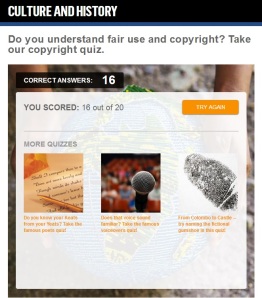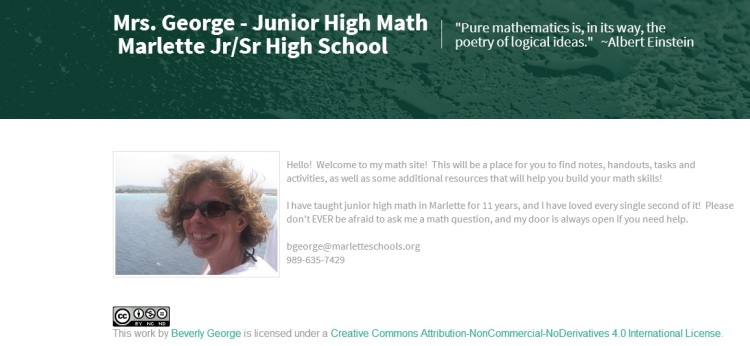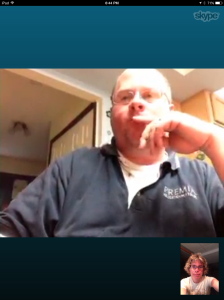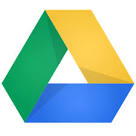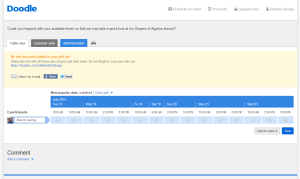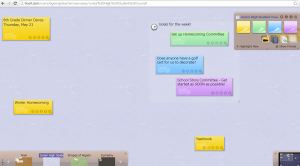MeL Educational Databases! I sincerely think this course name should be changed from “21 Things for Teachers” to “21 Things Teachers Will Immediately Fall in Love With”! I am embarrassed to admit, although here it all is for the world to see, that I’ve heard of MeL, but never really considered it as something my students would use. WHAT?? This is a resource that every Michigan student MUST be made aware of….as soon as school starts!! At any rate, moving forward and never looking back at my ignorance, I took a look at two databases recommended for the middle/high school level. I used SIRS Discoverer Deluxe and SIRS Renaissance to do a search on Pythagoras. I typically ask my students to do a little of thinking and research on mathematicians that made significant contributions to the content we are studying, and Pythagoras comes up quite often. SIRS Discoverer Deluxe brought up articles that were very brief and straightforward, and some of the articles even included a brief glossary of terms within the article.
SIRS Discoverer Deluxe Sample “Pythagoras of Samos.” Mathematicians Are People Too (National Center for Education Statistics). Jan. 7 2002: n.p. SIRS Discoverer. Web. 25 Jul. 2014.
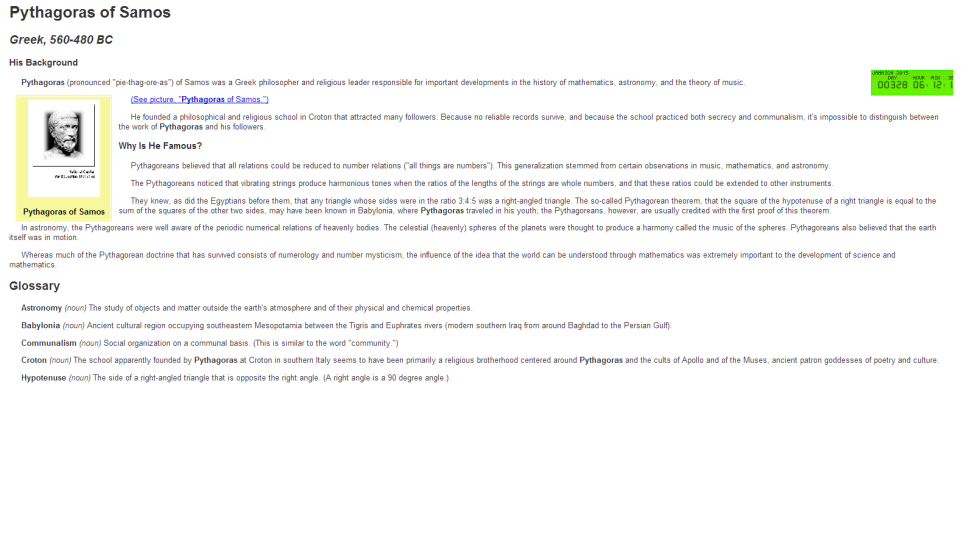
SIRS Renaissance Sample Williams, Michael R. “He Lived with Numbers.” World & I. May 2001: 140-147. SIRS Renaissance. Web. 25 Jul. 2014. 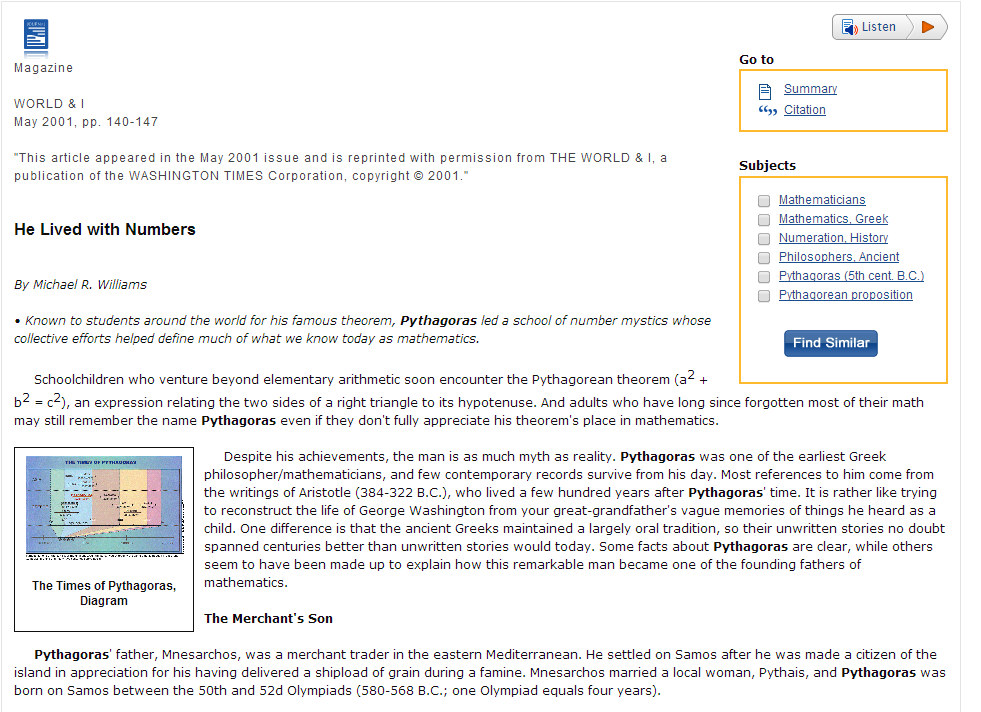
The SIRS Renaissance search provided some longer articles that had more in-depth information, consistent with what a high school or even college student would find helpful for conducting research. Overall, in the fields of appropriateness, usability, content, and credibility, SIRS Discoverer Deluxe is a perfect match for my 7th and 8th grade students while I would recommend the SIRS Renaissance database to my colleagues that teach at the high school level. As for the Best Practice of generating and testing hypotheses, MeL has provided a wealth of resources that are appropriate, usable, related to content, and credible for students that is beyond the garbage that can be found with a regular Google search. The handy citations at the bottom of each article make it incredibly easy for students to properly cite their work.
MeL Databases to Share With Students!
I have shared GeneralOne File with students on my website. Rather than answering their incessant “When will we ever use this?” question, I would like to encourage students to look for current articles that have some type of relation to math. This goes for InfoTrac Junior Edition as well. The Learning Express Library would be a great place for students to see which types of jobs require a math background, and it even looks like there are some practice math tests provided. Here is a quick shot of what my Math Resources page is starting to look like on my Weebly account.
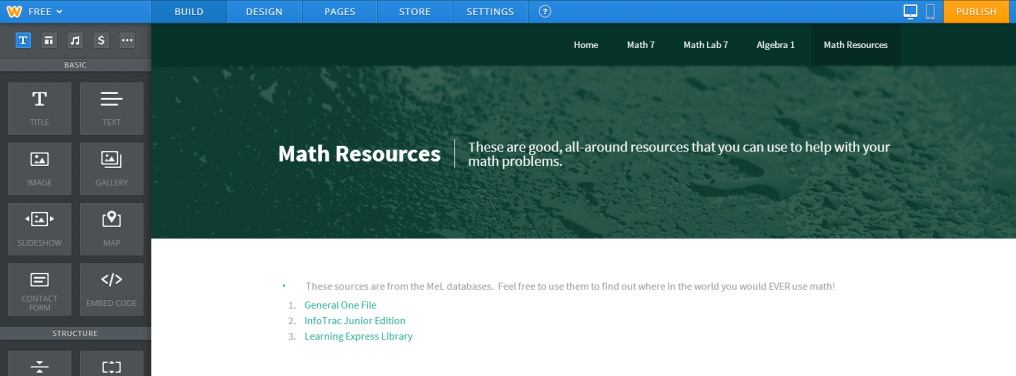
Bogus Sites – BEWARE!
- I checked out a couple of websites and used Joyce Valenza’s criteria using the ADVANCED (Secondary – CARRDSS) level. The first place I went was The Time Travel Fund site at http://www.timetravelfund.com/. Clearly, as you will see, there is no WAY this is a legitimate website. It fails every portion of Valenza’s test.
C – Credibility – The site looks sketchy from the start. The picture on the homepage has a load of people gathered around a Christmas scene holding up some very amateur-looking certificates.
A – Accuracy – The site directly states that they “do not know” what they can do, but they can only make “reasonable guesses”. Warning flags!
R – Reliability – In once spot, it says that international orders are not being taken, but then right below, it says that international orders take an extra dollar to process.
R – Relevance – The entire site is based on whether someone in the future would want to bring you to their place in time, and you have no choice as to where you go. Why would anyone not want to have that choice?
D – Date – There is not a date located anywhere on the page.
S – Sources Behind the Text – There are no sources listed at all.
S – Scope and Purpose – There is no real purpose behind this site other than to collect $10 from you. I’m a little worried about the PayPal certification, too!
C – Credibility – The PRNewswire logo at the top of the page looks pretty impressive, but there is nothing aside from the logo to indicate there is anything credible!
A – Accuracy – Redistributing the condiments 180 degrees so that the burger fits better for left-handers? Just turn the burger around and you’ll get the same results!
R – Reliability – The burger is said to become available in the UK on April 1? Perhaps the April Fools date will tip off some readers.
R – Relevance – It’s a round object, there is no reason to even consider how it would “fit better” into a left hand or right hand.
D – Date – There is no date located on the article or on the page itself aside from a 2013 copyright logo.
S – Sources Behind the Text – The source is list simply as “Burger King”. Quite generic if you ask me!
S – Scope and Purpose – There is no distinct scope or purpose behind this article.
Consequently, after investigating the PRNewswire contact information, it appears that ANYONE can submit a story to this site. Interesting! Having a few simple things to look for to evaluate the legitimacy of a website will go a long way towards making students more computer literate.
Citation Makers!
I have used these citation makers in both of my Masters programs, and I can’t imagine life without them!! I had to write several papers, each requiring a number of various resources. Creating the citations by hand early on was overwhelming and frustrating, but the moment I stumbled across a citation maker (I used the LandMark Citation Machine), life became much more pleasant. Through Google Scholar, I went back and searched my good friend Pythagoras and located a couple of quality articles that would be great for student use. For this assignment, I chose to use BibMe mostly because I’ve heard so many people talking about this one and wanted to check it out. WOW! This one is so much more user-friendly than what I was familiar with, and I was quickly able to locate two sources (a book and a website), and the citation was created with the click of a button.
- Boyer, Carl B.. A history of mathematics. New York: Wiley, 1968. Print.
- “Digital Commons @ Butler University.” – Undergraduate Research Conference: From Pythagoras to Johann Sebastian Bach: An Exploration in the Development of Temperament and Tuning. N.p., n.d. Web. 26 July 2014. <http://digitalcommons.butler.edu/urc/2014/m
ISTE Standards
1b Engage students in exploring real-world issues and solving authentic problems using digital tools and resources – Through the exploration of real world problems and their solutions, students will be required to do research. Using smart search strategies will help them to find reliable and accurate information for their solutions.
2a Design or adapt relevant learning experiences that incorporate digital tools and resources to promote student learning and creativity – Honing in student searches to assignments that are relevant to them will certainly engage them and keep them on task. If the cumbersome task of citing resources can be made less overwhelming through citation makers, students can continue to focus on solutions to real world problems.
3a Demonstrate fluency in technology systems and the transfer of current knowledge to new technologies and situations – Through the use of MeL and the databases, the instructor will be able to take the old-school library searches to something more current and accurate online.
4b Address the diverse needs of all learners by using learner-centered strategies providing equitable access to appropriate digital tools and resources – Again, the MeL databases are so diverse, there is certainly a resource and problem-solving opportunity available for each and every learning capability.
5c Evaluate and reflect on current research and professional practice on a regular basis to make effective use of existing and emerging digital tools and resources in support of student learning – I cannot stress enough how valuable the MeL databases can be. There is a particular section just for teachers that has what seems to be an infinite number of lessons and topics to keep teachers apprised of the current pedagogy and research in the education field. The MeL site should be visited regularly and frequently by EVERY teacher!
CITW
1 Generating and testing hypothesis – Having the MeL databases available to students as well as the citation generators will allow groups to formulate and research their real world problems. If they are able to approach each resource with a critical eye for what is accurate and credible and what is complete garbage, they will become better users of internet resources rather than straightforward consumers!
2 Cues, questions, and advanced organizers – A teacher could pose a real world problem to students, allowing them to use internet sources and smart searches to discover potential solutions to those questions.
3 Assigning homework and practice – An instructor could assign students to look up the origin of the idea of quadratic functions, finding the history of this concept that they could be addressing in math class. They could be required to write a short paragraph using credible sources that must be cited.
4 Identifying similarities and differences – A potential assignment for a collaborative group could be for them to research and locate the similarities and differences between how the Chinese and the Greeks contributed to mathematics and how their viewpoints on problem-solving compared.




